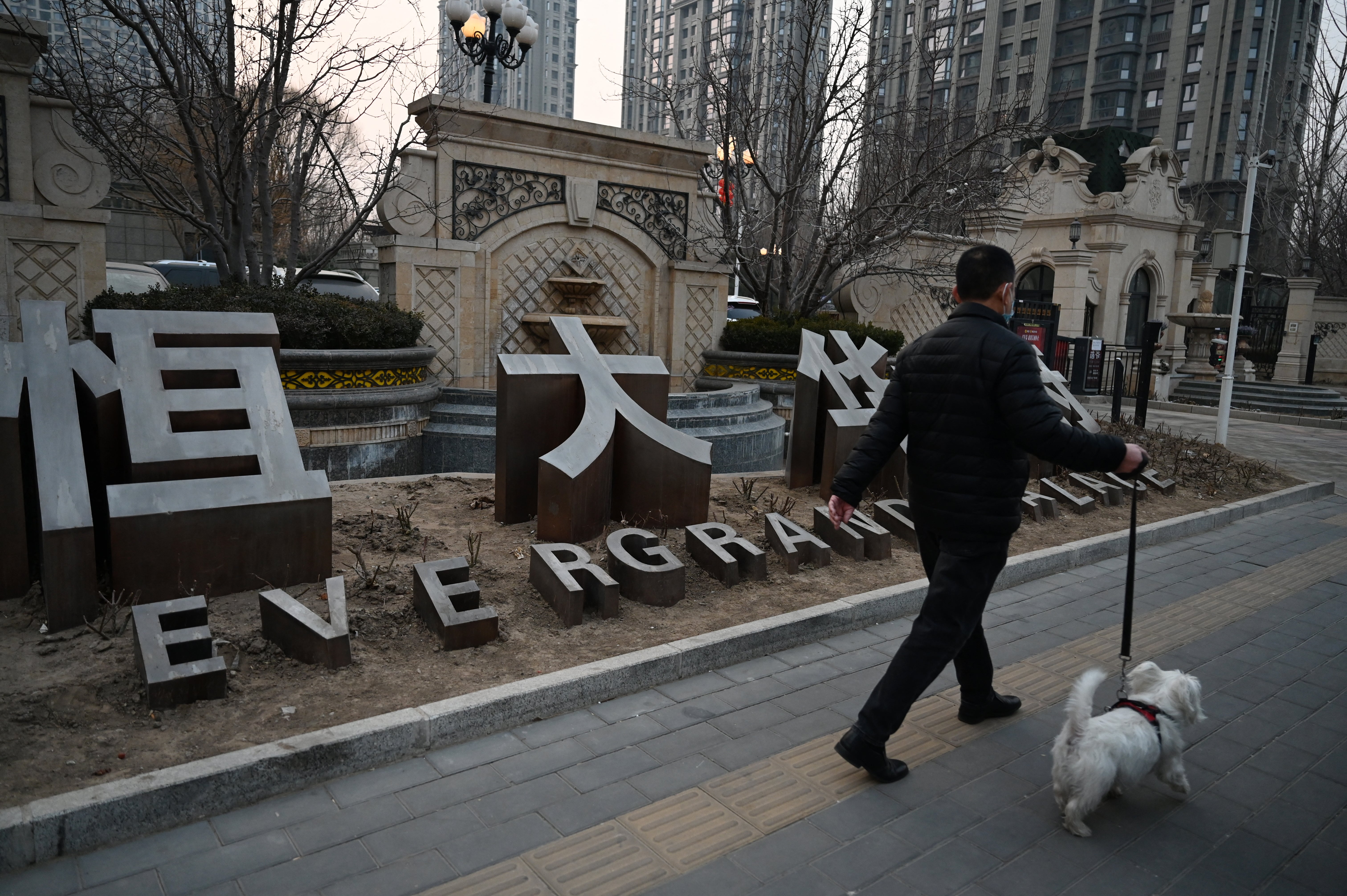Business
How the fall of Evergrande spells doom for China’s property market

The shares of China’s most indebted property giant Evergrande have been taken off the Hong Kong stock market, marking the end of its life as a publicly traded company that symbolised the rise and fall of China’s real estate industry.
Valued at more than $50 billion (£37.1bn) at its peak, Evergrande was China’s biggest property firm. But it became the poster-child for the problems facing Chinese developers after it collapsed under the weight of massive debts in 2021.
“Evergrande’s demise highlights that no private company in China is too big to fail,” Julian Evans-Pritchard, Head of China Economics at Capital Economics told The Independent.
“But the fact that it has taken this long for the company to be delisted underscores the slow-motion nature of China’s property adjustment, with state intervention preventing a more abrupt resolution.”
Evergrande’s 2021 default on offshore bonds led to its shares being suspended in January 2024, after a Hong Kong court ordered liquidation when years of restructuring talks failed.
Last week, the stock exchange confirmed it would cancel the listing because the firm failed to meet the requirement to resume trading within 18 months.
It comes as China’s economy is grappling with a series of challenges, including Trump’s tariffs, weak consumer spending, unemployment, high local government debt and an ageing population.
Experts say the collapse of the property sector has hit the country hardest, as it accounted for roughly a third of China’s economy and provided crucial revenue for local governments.
“It is a symbolic moment given that Evergrande was the first major casualty of China’s property downturn,” Mr Evans-Pritchard said. “The delisting itself won’t have a big impact given that the company’s market capitalisation had already collapsed and trading in the stock was suspended last year.”
“Although the company is being wound down, work on its projects is generally still ongoing, with local governments stepping in to make sure buyers eventually get the homes they bought.”
The company’s fall was as dramatic as its rise. Its founder, Hui Ka Yan, went from living a humble rural life to becoming one of Asia’s richest men.
Evergrande’s growth reflected the debt-fuelled nature of China’s property sector, which expanded rapidly following urbanisation and economic reforms in the 1990s.
Its 2009 listing marked a pivotal moment in that surge, with the company borrowing an unprecedented $20bn on international bond markets.
But the $45bn fortune that put Mr Hui at the top of the Forbes list of wealthiest men in Asia plummeted to less than $1bn.
By March 2024, Mr Hui was banned from China’s capital market for life over Evergrande’s overstating of its revenue by $78bn and he was fined $6.5m.
At the time of its collapse, Evergrande had an empire of 1,300 projects under development across 280 cities, an electric car business and Guangzhou FC. Earlier this year, China’s most successful team was itself kicked out of the football league due to debt.

Built on more than $300bn of borrowed money, Evergrande struggled to meet interest payments after Beijing introduced borrowing limits for developers in 2020.
Deep discounts on properties failed to prevent defaults on overseas debt, ultimately triggering liquidation.
The crisis wiped more than 99 percent from it stock market valuation.
Earlier this month, liquidators Alvarez & Marsal said they have so far recovered just $255m of assets, including a Claude Monet painting, out of the $45bn debt.
They also launched action against the firm’s auditors PwC China after authorities last March said it approved accounts despite inflated revenues in 2019 and 2020.
The housing crisis in China is far from over, with property firms like Country Garden still battling massive debt. Earlier this month China South City Holdings became the largest developer to be forced into liquidation since Evergrande.
“We think the property downturn is likely to continue for at least a couple more years, given that it will take time for the market to fully absorb excess supply as the backlog of unfinished projects are completed,” added Mr Evans-Pritchard.
Beijing launched a range of measures to revive the housing market and consumer spending, including incentives for new homeowners, stock market support, and purchases of electric cars and household goods.
Despite these efforts, China’s growth has slowed to around 5 percent, about half the rates seen in 2010.
Business
7th Pay Commission Nears End: What’s Next For Railway Salaries In 2026?

Last Updated:
Implemented in 2016, the 10-year term of the 7th Pay Commission will end in January 2026.
Stay Ahead, Read Faster
Scan the QR code to download the News18 app and enjoy a seamless news experience anytime, anywhere.


The 7th Pay Commission resulted in a 14–26% salary hike for railway employees. Implemented in 2016, its 10-year term will end in January 2026. According to an Economic Times report, Officials say Indian Railways is now focusing on cost-cutting and operational efficiency to ensure future pay revisions do not strain its finances.
Business
FIIs Sell Equity Worth Rs 15,959 Crore In Dec So Far, DIIs Buy For Rs 39,965 Crore

New Delhi: The foreign institutional investor (FII) selling is likely to decline in days to come as the economy is doing well, prospects for earnings growth are improving, and mutual fund SIPs are performing well, analysts said on Saturday.
In December so far, FIIs have sold equity worth Rs 15,959 crore through the exchanges.
This FII sell figure has been completely eclipsed by the domestic institutional investor (DII) buying for Rs 39,965 crore during this period, said market watchers.
“Sustained selling in India when the prospects for growth and earnings look bright is not a sustainable policy,” said Dr. VK Vijayakumar, Chief Investment Strategist, Geojit Investments Ltd.
A healthy feature of the investment behaviour of retail investors is the steady inflows into mutual fund SIPs, which have been consistently above Rs 29,000 crore during the last three months.
SIP inflows in November remained almost steady at Rs 29,445 crore, according to data released by the Association of Mutual Funds in India (AMFI).
According to Vijayakumar, this has enabled the DIIs to absorb the sustained selling by FIIs.
“FIIs have been sustained sellers in December, so far, selling on all days. It would be difficult for the FIIs to sell continuously and maintain a high short position in the market in the context of healthy SIP inflows, particularly when the economy is doing well and the prospects for earnings growth are improving,” he noted.
According to analysts, it is also important to understand that rupee depreciation, sustained FII selling, delay in the finalisation of US-India trade deal and the ongoing AI trade are all temporary drags on the markets.
In November, both FIIs and DIIs were net buyers (to the tune of USD 40 million and USD 8.7 billion, respectively) in the Indian equity market.
Over the last 12 months, the Indian primary markets have seen FII net inflows to the tune of Rs 823 billion (USD 9.5 billion) while secondary markets have seen FII net outflows of Rs 2,144 billion (USD 24.5 billion), according to a note by JM Financial.
In November, India’s weight in the MSCI Emerging Markets Index was 15.8 per cent against 15.2 per cent in October and 19.9 per cent in November.
According to analysts, the most important factor that will dictate the direction of the market is the earnings growth, and this looks promising for FY27.
Business
China’s smaller manufacturers look to catch the automation wave – The Times of India

In a light-filled workshop in eastern China, a robotic arm moved a partially assembled autonomous vehicle as workers calibrated its cameras, typical of the incremental automation being adopted even across smaller factories in the world’s manufacturing powerhouse.China is already the world’s largest market for industrial robots, and the government is pouring billions of dollars into robotics and artificial intelligence to boost its presence in the sector.
The first essentially humanlessfactoriesare already in operation, even as widespread automation raises questions about job losses as well as the cost and difficulty of transition for smaller and medium-sized companies. The answer for many is a hybrid approach, experts and factory owners told AFP. At the autonomous vehicle workshop, manager Liu Jingyao told AFP that humans are still a crucial part of even technologically advanced manufacturing. “Many decisions require human judgement,” said Liu, whose company Neolix produces small van-like vehicles that transport parcels across Chinese cities. “These decisions involve certain skill-based elements that still need to be handled by people.”At the Neolix factory, 300 kilometres (186 miles) north of Shanghai, newly built driverless vehicles zoomed around a testing track simulating obstacles including puddles and bridges.In a closed-off room, workers assembled vehicles’ “brains”, testing their cameras and computer chips.“Automation… primarily serve(s) to assist humans, reducing labour intensity rather than replacing them,” Liu said.But Ni Jun, a mechanical engineering expert at Shanghai’s Jiaotong University, said China’s strategy of focusing on industrial applications for AI means full automation is already feasible in many sectors.Among others, tech giant Xiaomi operates a “dark factory” — where the absence of people means no need for lights — with robotic arms and sensors able to make smartphones without humans.– Digital divide –Ni described a “digital divide” between larger companies with the funds to invest heavily in modernisation, and smaller businesses struggling to keep up.For Zhu Yefeng’s Far East Precision Printing Company, part of China’s vast network of small independent factories employing up to a few dozen people each, full automation is a distant dream.At the company just outside Shanghai, workers in small rooms fed sheets of instruction manuals into folding machines and operated equipment that printed labels for electronic devices.The company used pen and paper to track its workflow until two years ago, with managers having to run around the factory to communicate order information.“Things were, to put it bluntly, a complete mess,” Zhu told AFP.The company has since adopted software that allows employees to scan QR codes that send updates to a factory-wide tracker.On a screen in his office, Zhu can see detailed charts breaking down each order’s completion level and individual employees’ productivity statistics.“This is a start,” Zhu told AFP. “We will move toward more advanced technology like automation, in order to receive even bigger orders from clients.”Financial constraints are a major barrier though. “As a small company, we can’t afford certain expenses,” said Zhu. His team is trying to develop its own robotic quality testing machine, but for now humans continue to check final products.– Employment pressures –The potential unemployment caused by widespread automation will be a challenge, said Jacob Gunter from the Berlin-based Mercator Institute for China Studies. “Companies will be quite happy to decrease their headcount… but the government will not like that and will be under a lot of pressure to navigate this,” Gunter told AFP.Beijing’s push to develop industrial robots will “intersect with the need for maintaining high employment at a time when employment pressure is considerable”, he added. Going forward, manufacturers must strike a balance “between the technical feasibility, social responsibility, and business necessity”, Jiaotong University’s Ni told AFP.Zhou Yuxiang, the CEO of Black Lake Technologies — the start-up that provided the software for Zhu’s factory — told AFP he thought factories would “always be hybrid”. “If you ask every owner of a factory, is a dark factory the goal? No, that’s just a superficial description,” Zhou said. “The goal for factories is to optimise production, deliver things that their end customers want, and also make money.”
-

 Politics6 days ago
Politics6 days agoThailand launches air strikes against Cambodian military: army
-

 Tech1 week ago
Tech1 week agoWIRED Roundup: DOGE Isn’t Dead, Facebook Dating Is Real, and Amazon’s AI Ambitions
-

 Sports1 week ago
Sports1 week agoAustralia take control of second Ashes Test | The Express Tribune
-

 Politics6 days ago
Politics6 days agoZelenskiy says Ukraine’s peace talks with US constructive but not easy
-

 Fashion6 days ago
Fashion6 days agoGermany’s LuxExperience appoints Francis Belin as new CEO of Mytheresa
-

 Business1 week ago
Business1 week agoNetflix to buy Warner Bros. film and streaming assets in $72 billion deal
-

 Politics1 week ago
Politics1 week ago17 found dead in migrant vessel off Crete: coastguard
-

 Politics3 days ago
Politics3 days agoTrump launches gold card programme for expedited visas with a $1m price tag







